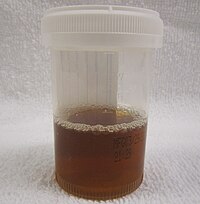
Photo from wikipedia
The United States Food and Drug Administration Adverse Event Reporting System (FAERS) logged 27,140 rhabdomyolysis cases from 2004 to 31 March 2020. We used FAERS to identify 14 drugs frequently… Click to show full abstract
The United States Food and Drug Administration Adverse Event Reporting System (FAERS) logged 27,140 rhabdomyolysis cases from 2004 to 31 March 2020. We used FAERS to identify 14 drugs frequently reported in 6583 rhabdomyolysis cases and to investigate whether mitochondrial toxicity is a common pathway of drug-induced rhabdomyolysis by these drugs. Preliminary screening for mitochondrial toxicity was performed using the acute metabolic switch assay, which is adapted here for use in murine L6 cells. Fenofibrate, risperidone, pregabalin, propofol, and simvastatin lactone drugs were identified as mitotoxic and underwent further investigation, using real-time respirometry (Seahorse Technology) to provide more detail on the mechanism of mitochondrial-induced toxicity. To confirm the human relevance of the findings, fenofibrate and risperidone were evaluated in primary human skeletal muscle-derived cells (HSKMDC), using the acute metabolic switch assay and real-time respirometry, which confirmed this designation, although the toxic effects on the mitochondria were more pronounced in HSKMDC. Overall, these studies demonstrate that the L6 model of acute modification may find utility as an initial, cost-effective screen for identifying potential myotoxicants with relevance to humans and, importantly, that drug-induced mitochondrial dysfunction may be a common mechanism shared by some drugs that induce myotoxicity.
Journal Title: Biomedicines
Year Published: 2023
Link to full text (if available)
Share on Social Media: Sign Up to like & get
recommendations!